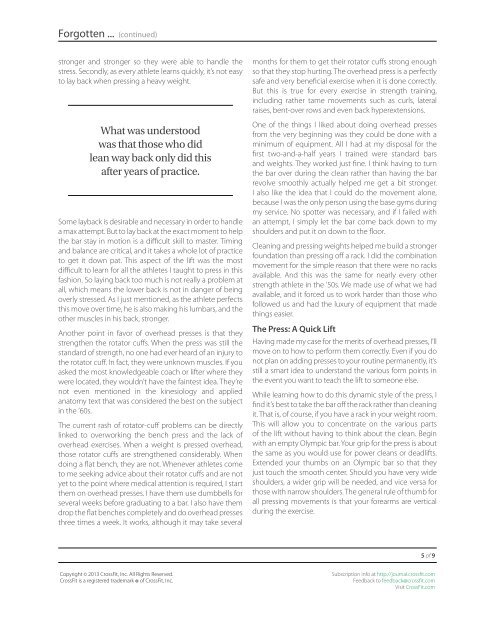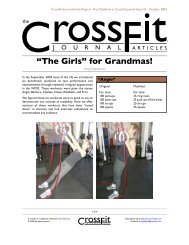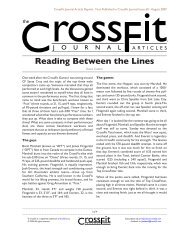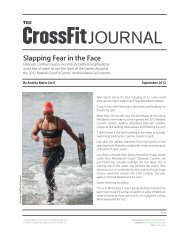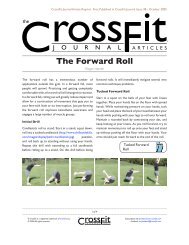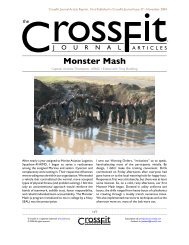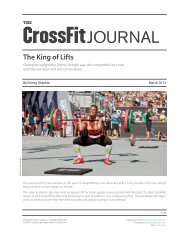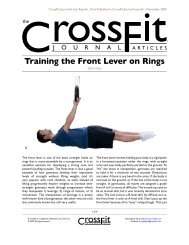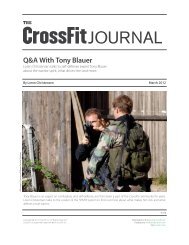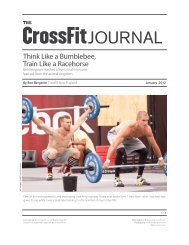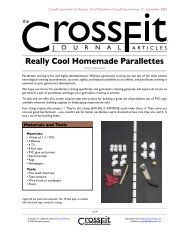JOURNAL - CrossFit
JOURNAL - CrossFit
JOURNAL - CrossFit
Create successful ePaper yourself
Turn your PDF publications into a flip-book with our unique Google optimized e-Paper software.
Forgotten ... (continued)<br />
stronger and stronger so they were able to handle the<br />
stress. Secondly, as every athlete learns quickly, it’s not easy<br />
to lay back when pressing a heavy weight.<br />
What was understood<br />
was that those who did<br />
lean way back only did this<br />
after years of practice.<br />
Some layback is desirable and necessary in order to handle<br />
a max attempt. But to lay back at the exact moment to help<br />
the bar stay in motion is a difficult skill to master. Timing<br />
and balance are critical, and it takes a whole lot of practice<br />
to get it down pat. This aspect of the lift was the most<br />
difficult to learn for all the athletes I taught to press in this<br />
fashion. So laying back too much is not really a problem at<br />
all, which means the lower back is not in danger of being<br />
overly stressed. As I just mentioned, as the athlete perfects<br />
this move over time, he is also making his lumbars, and the<br />
other muscles in his back, stronger.<br />
Another point in favor of overhead presses is that they<br />
strengthen the rotator cuffs. When the press was still the<br />
standard of strength, no one had ever heard of an injury to<br />
the rotator cuff. In fact, they were unknown muscles. If you<br />
asked the most knowledgeable coach or lifter where they<br />
were located, they wouldn’t have the faintest idea. They’re<br />
not even mentioned in the kinesiology and applied<br />
anatomy text that was considered the best on the subject<br />
in the ’60s.<br />
The current rash of rotator-cuff problems can be directly<br />
linked to overworking the bench press and the lack of<br />
overhead exercises. When a weight is pressed overhead,<br />
those rotator cuffs are strengthened considerably. When<br />
doing a flat bench, they are not. Whenever athletes come<br />
to me seeking advice about their rotator cuffs and are not<br />
yet to the point where medical attention is required, I start<br />
them on overhead presses. I have them use dumbbells for<br />
several weeks before graduating to a bar. I also have them<br />
drop the flat benches completely and do overhead presses<br />
three times a week. It works, although it may take several<br />
Copyright © 2013 <strong>CrossFit</strong>, Inc. All Rights Reserved.<br />
<strong>CrossFit</strong> is a registered trademark ® of <strong>CrossFit</strong>, Inc.<br />
months for them to get their rotator cuffs strong enough<br />
so that they stop hurting. The overhead press is a perfectly<br />
safe and very beneficial exercise when it is done correctly.<br />
But this is true for every exercise in strength training,<br />
including rather tame movements such as curls, lateral<br />
raises, bent-over rows and even back hyperextensions.<br />
One of the things I liked about doing overhead presses<br />
from the very beginning was they could be done with a<br />
minimum of equipment. All I had at my disposal for the<br />
first two-and-a-half years I trained were standard bars<br />
and weights. They worked just fine. I think having to turn<br />
the bar over during the clean rather than having the bar<br />
revolve smoothly actually helped me get a bit stronger.<br />
I also like the idea that I could do the movement alone,<br />
because I was the only person using the base gyms during<br />
my service. No spotter was necessary, and if I failed with<br />
an attempt, I simply let the bar come back down to my<br />
shoulders and put it on down to the floor.<br />
Cleaning and pressing weights helped me build a stronger<br />
foundation than pressing off a rack. I did the combination<br />
movement for the simple reason that there were no racks<br />
available. And this was the same for nearly every other<br />
strength athlete in the ’50s. We made use of what we had<br />
available, and it forced us to work harder than those who<br />
followed us and had the luxury of equipment that made<br />
things easier.<br />
The Press: A Quick Lift<br />
Having made my case for the merits of overhead presses, I’ll<br />
move on to how to perform them correctly. Even if you do<br />
not plan on adding presses to your routine permanently, it’s<br />
still a smart idea to understand the various form points in<br />
the event you want to teach the lift to someone else.<br />
While learning how to do this dynamic style of the press, I<br />
find it’s best to take the bar off the rack rather than cleaning<br />
it. That is, of course, if you have a rack in your weight room.<br />
This will allow you to concentrate on the various parts<br />
of the lift without having to think about the clean. Begin<br />
with an empty Olympic bar. Your grip for the press is about<br />
the same as you would use for power cleans or deadlifts.<br />
Extended your thumbs on an Olympic bar so that they<br />
just touch the smooth center. Should you have very wide<br />
shoulders, a wider grip will be needed, and vice versa for<br />
those with narrow shoulders. The general rule of thumb for<br />
all pressing movements is that your forearms are vertical<br />
during the exercise.<br />
5 of 9<br />
Subscription info at http://journal.crossfit.com<br />
Feedback to feedback@crossfit.com<br />
Visit <strong>CrossFit</strong>.com


